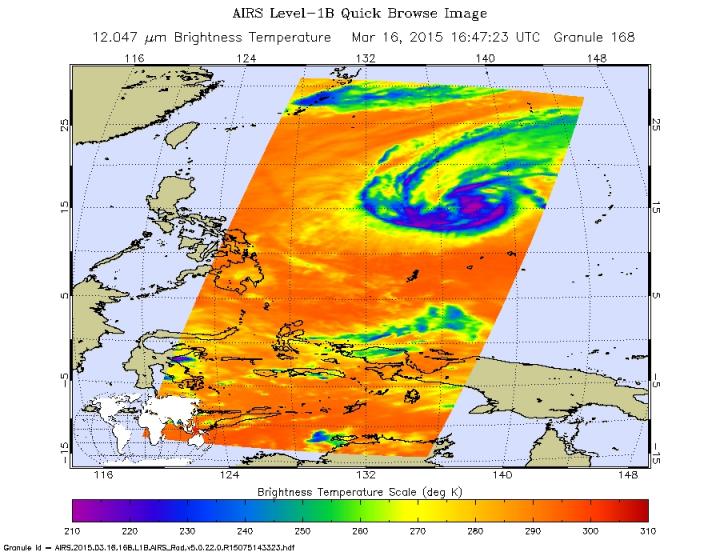NASA sees Tropical Cyclone Bavi losing steam

This false-colored image shows warming infrared temperature data of Tropical Cyclone Bavi's clouds on March 16 at 16:47 UTC, as seen by the AIRS instrument aboard NASA's Aqua satellite. Credit: NASA JPL
The Atmospheric Infrared Sounder or AIRS instrument that flies aboard NASA's Aqua satellite revealed warming infrared temperature data of Tropical Cyclone Bavi's clouds on March 16 at 16:47 UTC (10:47 a.m. EDT).
At 0900 UTC (5 a.m. EDT) on March 17, 2015 the Joint Typhoon Warning Center (JTWC) noted that “Recent animated enhanced infrared satellite imagery showed the system is stripped of any significant deep convection.”
That's as a result of moderate to strong (20 to 30 knot/23 to 34.5 mph/37 to 55.5 kph) southwesterly vertical wind shear.
The imagery showed a ragged low-level circulation center and cloud top temperatures had warmed over the previous 24 hours. Warming cloud tops indicate that the cloud tops are dropping and the storms are weakening.
Bavi has weakened to a depression with maximum sustained winds near 30 knots (35 mph/55 kph). Bavi was centered near 15.6 north latitude and134.5 east longitude, about 784 nautical miles (902 miles/1,453 km) east of Manila, Philippines. Bavi was moving to the west-northwest at 8 knots (9.2 mph/14.8 kph).
Bavi is moving to the west, tracking along the southern edge of a sub-tropical ridge (elongated area) of high pressure to the north. The JTWC expects Bavi to dissipate in the next day or two.
Media Contact
All latest news from the category: Earth Sciences
Earth Sciences (also referred to as Geosciences), which deals with basic issues surrounding our planet, plays a vital role in the area of energy and raw materials supply.
Earth Sciences comprises subjects such as geology, geography, geological informatics, paleontology, mineralogy, petrography, crystallography, geophysics, geodesy, glaciology, cartography, photogrammetry, meteorology and seismology, early-warning systems, earthquake research and polar research.
Newest articles

Silicon Carbide Innovation Alliance to drive industrial-scale semiconductor work
Known for its ability to withstand extreme environments and high voltages, silicon carbide (SiC) is a semiconducting material made up of silicon and carbon atoms arranged into crystals that is…

New SPECT/CT technique shows impressive biomarker identification
…offers increased access for prostate cancer patients. A novel SPECT/CT acquisition method can accurately detect radiopharmaceutical biodistribution in a convenient manner for prostate cancer patients, opening the door for more…

How 3D printers can give robots a soft touch
Soft skin coverings and touch sensors have emerged as a promising feature for robots that are both safer and more intuitive for human interaction, but they are expensive and difficult…




















